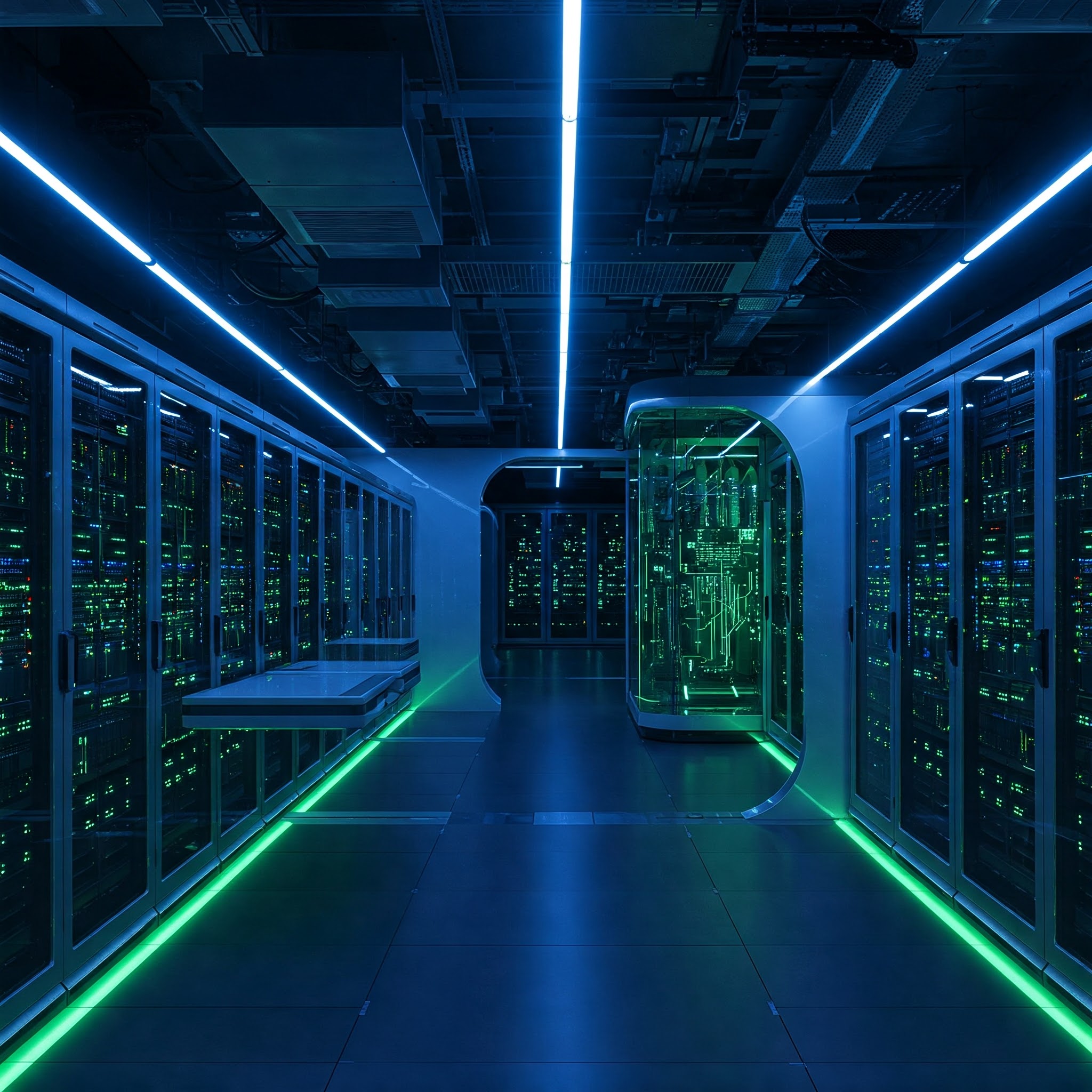AI in Data Centers | Beyond Hype, How It’s Transforming Operations
💡 AI in Data Centers: Game-Changer or Just Hype?
Imagine this: A massive data center humming with thousands of servers, consuming enough electricity to power a small city. Now, picture an AI system fine-tuning energy consumption in real-time, predicting hardware failures before they happen, and optimizing workloads—all without human intervention.
Sounds futuristic? It’s already happening.
Tech giants like Google, Microsoft, and Meta are deploying AI to cut costs, improve efficiency, and enhance security in their data centers. Google’s AI-powered cooling system alone reduced energy usage by 40%, saving millions annually. 🚀
But is AI in data centers truly revolutionary, or is it just another buzzword? Let’s break down how AI is reshaping the future of digital infrastructure.
Why AI is Needed in Data Centers: The Growing Challenges
Data centers are the beating heart of the digital world, but as demand skyrockets, traditional management approaches are struggling to keep up. Here’s why AI is no longer a luxury—it’s a necessity.
📈 Unstoppable Growth, Unmanageable Complexity
The volume of data generated worldwide is projected to reach 181 zettabytes by 2025 (Statista). Cloud computing, AI workloads, and IoT devices are pushing data centers to their limits. Manual operations simply can’t scale fast enough to handle this explosive growth.
- Server sprawl: Large-scale data centers now house millions of servers, making real-time monitoring and maintenance nearly impossible without automation.
- Workload variability: AI applications, video streaming, and cloud computing create fluctuating workloads that require dynamic resource allocation, which humans can’t manage optimally in real time.
⚡ Energy Consumption: A Growing Crisis
Data centers account for 1–2% of global electricity consumption, a figure that is expected to double by 2030 (Uptime Institute). Cooling systems alone consume up to 40% of a data center’s energy, making efficiency a top priority.
- AI-driven predictive cooling can optimize power usage, reducing costs and carbon footprints.
- Companies like Google have already used AI to cut cooling costs by 40%, demonstrating massive potential for sustainability.
🛡️ Cybersecurity & System Failures: Human-Led Operations Fall Short
The rise of ransomware attacks and sophisticated cyber threats means security must be proactive, not reactive. Traditional monitoring methods are too slow to detect and respond to threats in real time.
- AI-powered anomaly detection can identify suspicious activity before it escalates.
- Predictive analytics can forecast hardware failures, reducing costly downtime.
🔍 What the Experts Say
Industry leaders agree that AI is becoming essential:
- Gartner predicts that by 2027, 75% of enterprises will deploy AI-driven infrastructure management to enhance performance and reduce operational risks.
- McKinsey highlights that AI-powered data center optimizations can improve energy efficiency by 30% and reduce unplanned outages by 50%.
- Uptime Institute reports that AI-driven automation is critical for sustainable, scalable, and secure data center operations.
🚀 The Bottom Line
As data centers grow in size and complexity, AI isn’t just a competitive advantage—it’s a survival necessity. In the next section, we’ll explore how AI is already transforming data center operations and what’s next on the horizon.
How AI is Transforming Data Centers Today
AI isn’t just a futuristic concept—it’s already reshaping data center operations in three key areas: efficiency, reliability, and security.

⚡ 1. AI for Energy Optimization & Sustainability
One of the biggest challenges for data centers is energy consumption. AI is helping companies cut costs and reduce their carbon footprint through intelligent power management.
🔹 AI-Powered Cooling – Using Reinforcement Learning, Google’s DeepMind AI reduced data center cooling energy by 40% by dynamically adjusting temperature and airflow.
🔹 Smart Power Allocation – AI balances workloads across servers, minimizing energy waste and preventing overheating.
🔹 Renewable Energy Integration – AI predicts power demand and helps data centers efficiently integrate solar and wind energy, reducing dependence on non-renewable sources.
✅ Impact: Lower operational costs, reduced environmental impact, and compliance with green regulations.
🛠️ 2. AI for Predictive Maintenance & Downtime Prevention
Unplanned outages cost businesses millions of dollars per hour. AI is now preventing failures before they happen.
🔹 Predictive Hardware Failures – With Time-Series Analysis and Machine Learning Classifiers, AI models analyze sensor data from servers and detect early signs of hardware degradation.
🔹 Automated Troubleshooting – Instead of waiting for a system failure, AI diagnoses issues in real time and recommends fixes before they escalate.
🔹 Robotics & AI Collaboration – In some facilities, robots equipped with AI perform routine maintenance checks, reducing reliance on manual inspections.
✅ Impact: 50% reduction in unexpected downtime (McKinsey), leading to huge cost savings for cloud providers.
🛡️ 3. AI for Cybersecurity & Threat Detection
With cyberattacks on the rise, AI is now being deployed for real-time threat monitoring and automated response.
🔹 Anomaly Detection – Anomaly Detection Algorithms and Deep Learning Models enables AI to analyze network traffic patterns and flags unusual activity before a breach occurs.
🔹 Automated Incident Response – AI security tools like Microsoft’s Defender AI and Google’s Chronicle Security respond to threats instantly.
🔹 Zero-Trust AI Models – AI-driven authentication systems ensure only verified users access critical infrastructure.
✅ Impact: Faster threat detection and proactive defense against cyberattacks.
What’s Next? The Future of AI in Data Centers
While AI has already made a huge impact, we’re just scratching the surface of what’s possible.

🤖 The Rise of Autonomous Data Centers
Companies are exploring fully AI-managed data centers, where:
✔ AI-driven robotic systems handle server repairs.
✔ Self-learning AI optimizes power, performance, and security in real time.
✔ Human oversight is minimal, allowing for cost-effective, 24/7 operations.
💡 Equinix & Meta are already testing autonomous operations, and analysts predict 80% of large-scale data centers will be AI-managed by 2030.
🔗 AI & Edge Computing: A Powerful Combination
As IoT and 5G expand, edge data centers will need AI for real-time processing. Expect:
✔ AI-optimized micro data centers closer to users.
✔ AI chips that enhance processing speeds and reduce latency.
✔ AI-driven network orchestration for seamless cloud-edge integration.
🧠 AI-Powered Decision-Making & AIOps
Future AI models won’t just assist human operators—they’ll make autonomous decisions.
✔ AI will manage data center traffic based on real-time demand.
✔ Self-learning algorithms will adjust resource allocation dynamically.
✔ AIOps (AI for IT Operations) will handle incident management without human intervention.
🚀 Final Thoughts: AI is the Future of Data Centers
The data center industry is at a tipping point. With explosive data growth, rising energy demands, and increasing cyber threats, AI isn’t just an innovation—it’s a necessity.
🌍 AI-driven automation is making data centers more efficient, secure, and sustainable.
💡 As AI evolves, we may soon see fully autonomous data centers requiring little to no human intervention. However, it is important to acknowledge the challenges of AI implementation, including data quality, integration with legacy systems, talent acquisition, and model drift.
👉 Do you think AI will completely take over data center operations, or will human oversight always be needed? Let’s discuss!



